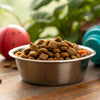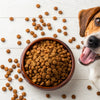Can You Wet Dry Dog Food? Exploring the Benefits and Best Practices
- Houndsy
Table of Contents
- Introduction
- The Benefits of Adding Water to Dry Dog Food
- The Drawbacks of Wetting Dry Dog Food
- How to Properly Add Water to Dry Dog Food
- Conclusion
Introduction
As dog owners, we are constantly seeking the best ways to nourish our furry companions. Many of us have asked ourselves: Can you wet dry dog food? This simple question opens the door to a myriad of considerations regarding canine nutrition, hydration, and overall health. Recent studies indicate that nearly 70% of dog owners add water to their pets' dry food, suggesting a growing awareness of the benefits this practice can offer.
In this blog post, we will dive into the benefits and potential drawbacks of adding water to dry dog food, as well as practical tips for doing so effectively. By the end of this article, you'll have a comprehensive understanding of whether this practice is suitable for your dog and how it can enhance their feeding experience.
We'll cover the nutritional implications, hydration benefits, and how to properly moisten kibble, all while reflecting on our mission at Houndsy: to simplify and elevate the dog-feeding experience. So, whether you're a new pet parent or a seasoned dog lover, let’s explore the nuances of wetting dry dog food together.
The Benefits of Adding Water to Dry Dog Food
Improved Hydration
One of the most compelling reasons to consider wetting your dog's dry food is to enhance hydration. Dogs, like humans, need an adequate intake of fluids for their bodies to function optimally. Many dogs do not drink enough water throughout the day, leading to potential dehydration and related health issues such as urinary tract infections and kidney problems. By adding water to their kibble, we can help ensure our pets receive the hydration they need.
Consider this: dogs are often reluctant drinkers. If you notice your pup isn’t consuming enough water, moistening their dry food can serve as a creative solution. When we add water, we not only increase the moisture content of their meal but also make it more enticing, thus encouraging them to eat and drink simultaneously.
Enhanced Palatability
Another significant advantage of adding water to dry kibble is the enhancement of flavor and aroma. Just as we enjoy a delicious stew over a dry meal, our dogs also appreciate the increased palatability that comes from moist food. Hydrating kibble can unleash the aromas trapped in the dry pellets, making mealtime a more enjoyable experience for our pets.
For picky eaters or dogs recovering from illness, this simple trick can turn bland kibble into a tantalizing feast. Imagine watching your dog eagerly devour their meal simply because you've added a splash of warm water.
Easier to Chew and Digest
For dogs with dental issues—whether they are seniors or have had teeth removed—soaking dry food can make it easier for them to chew and swallow. Softening the kibble reduces the strain on their teeth and gums, allowing them to enjoy their meals without discomfort. Additionally, moistened food can be gentler on the digestive system, reducing the risk of gastrointestinal upset.
When we consider that some dogs may struggle to digest dry kibble, particularly larger breeds or those prone to bloat, adding water can facilitate a smoother digestive process. It’s like turning the kibble into a comforting, digestible soup for our canine companions.
Increased Satiety
Adding water to dry kibble can also help dogs feel fuller after meals. Dry kibble is calorie-dense, and some dogs may not feel satisfied after eating the appropriate serving size. By moistening their food, we can increase its volume, which may help curb overeating and the associated risks of obesity. This can be particularly beneficial for dogs that tend to inhale their food, as the added moisture slows down their eating tempo.
The Drawbacks of Wetting Dry Dog Food
Potential for Spoilage
While there are numerous benefits to adding water to dry dog food, there are also some drawbacks to consider. One of the most significant concerns is the increased potential for spoilage. Moist food can create an ideal environment for bacterial growth, especially if left out at room temperature for extended periods. This can lead to digestive upset and more serious health issues for our beloved pets.
To mitigate this risk, it's important to serve the moistened kibble immediately and to discard any uneaten portions after 60 minutes. If you're concerned about spoilage, consider serving smaller portions to ensure your dog consumes their meal promptly.
Loss of Nutritional Value
Another consideration is the potential loss of nutrients when wetting dry kibble. Some vitamins and minerals may leach into the water, particularly if the food is soaked for too long. This is especially true for water-soluble vitamins. To preserve the nutritional integrity of your dog’s meal, it’s advisable to add water just before serving and avoid soaking the kibble for extended periods.
Dental Health Concerns
While moistening food can benefit dogs with dental problems, it can also reduce the dental benefits provided by dry kibble. The crunch of dry kibble can help scrape away plaque and tartar from teeth. By soaking kibble, we may diminish this "toothbrush effect," which could be a concern for dogs with otherwise healthy teeth.
To strike a balance, we can consider offering dry kibble intermittently to promote dental health while also providing moistened meals for comfort and hydration.
How to Properly Add Water to Dry Dog Food
Start Slow
If you’re new to wetting dog food, it’s best to start slowly. Begin by adding a small amount of water—about half a cup for every cup of kibble. Observe your dog's reaction and adjust the water level as needed. Some dogs may take time to adjust to the new texture, so gradual changes can help ease this transition.
Warm Water is Best
Using warm water can enhance the palatability of the kibble. Warm water helps to release the flavors and aromas trapped in the dry food. However, be cautious not to use boiling water, as high temperatures can damage certain nutrients and probiotics. Ideally, water should be warm but not exceed 120°F.
Timing is Key
Allow the kibble to soak for about 7 to 10 minutes before serving. This timeframe is generally sufficient for the kibble to soften without becoming mushy. It's essential to check the texture to ensure it's not floating in water, as this may deter your dog from eating.
Monitor Your Dog’s Response
As with any dietary change, it’s important to monitor your dog’s response to the moistened kibble. Observe their eating habits, digestion, and overall well-being. If any issues arise, consult your veterinarian for tailored advice.
Conclusion
In summary, the practice of wetting dry dog food can enhance hydration, palatability, and ease of digestion for our furry friends. However, it is essential to be mindful of the potential drawbacks, such as spoilage and the loss of nutritional value. Balancing the benefits and drawbacks allows us to make informed decisions about our dogs' feeding routines.
At Houndsy, we believe that thoughtful feeding practices can simplify and elevate the everyday experience of pet ownership. If you're interested in enhancing your pet's feeding experience, consider our Houndsy Kibble Dispenser, which is designed with convenience and modern aesthetics in mind. Explore the Houndsy Kibble Dispenser here!
FAQ
Can all dogs benefit from wetting dry dog food?
While many dogs can benefit from this practice, it's essential to consider your dog's individual needs. Dogs with dental issues or hydration concerns are likely to benefit the most.
How long can I leave wet dog food out?
It's best to serve moistened kibble immediately and discard any leftovers after 60 minutes to avoid spoilage.
Does adding water alter the nutritional value of dry dog food?
Yes, some nutrients may leach into the water if the food is soaked for too long. To minimize this, add water just before serving.
Will wetting kibble make my dog overeat?
There is a potential for overeating since moistened food can be more palatable. Monitor your dog's eating habits and adjust portion sizes as needed.
Is there a best time to add water to dry dog food?
Adding water just before serving is ideal. This ensures the food remains fresh and maintains its nutritional integrity.
By implementing these practices, we can ensure our dogs enjoy their meals while remaining healthy and hydrated. Let’s continue to explore ways to enhance our pets' feeding experience together!













